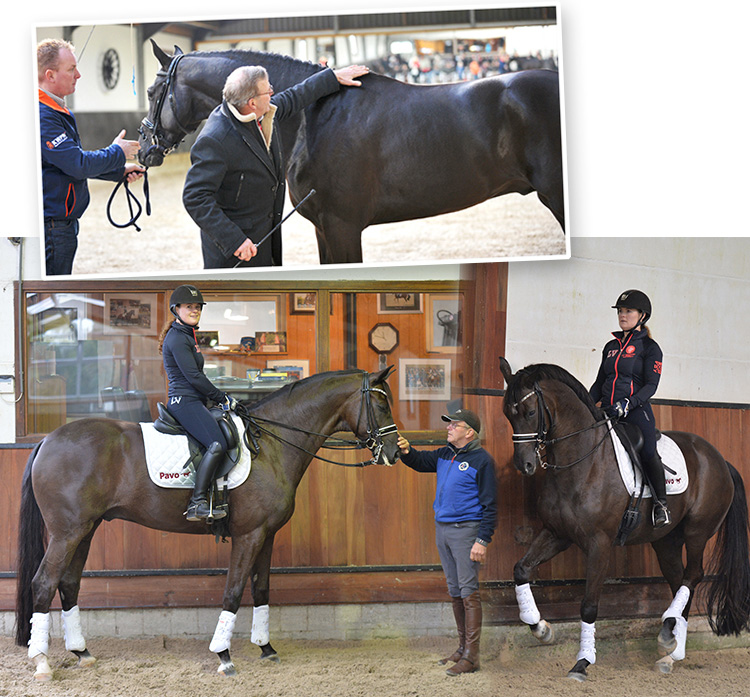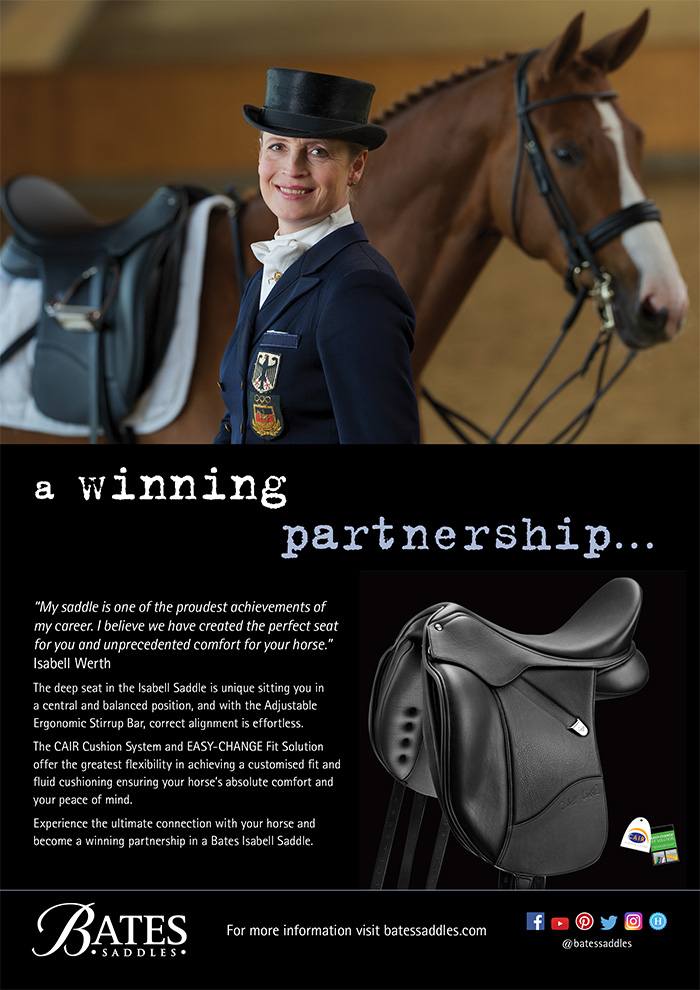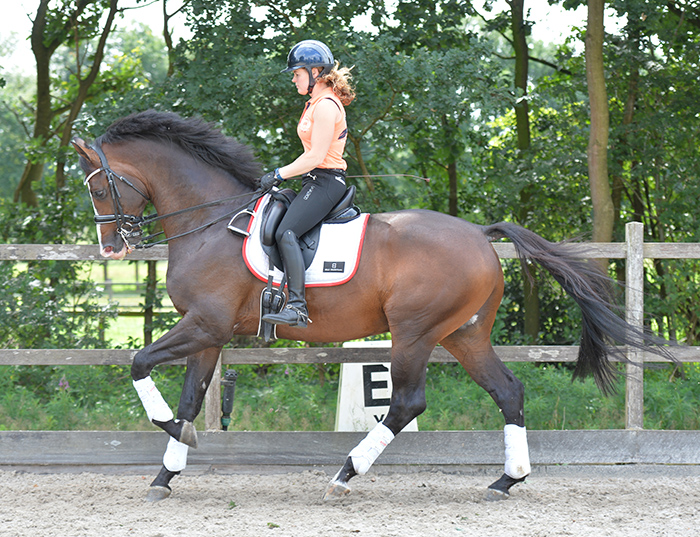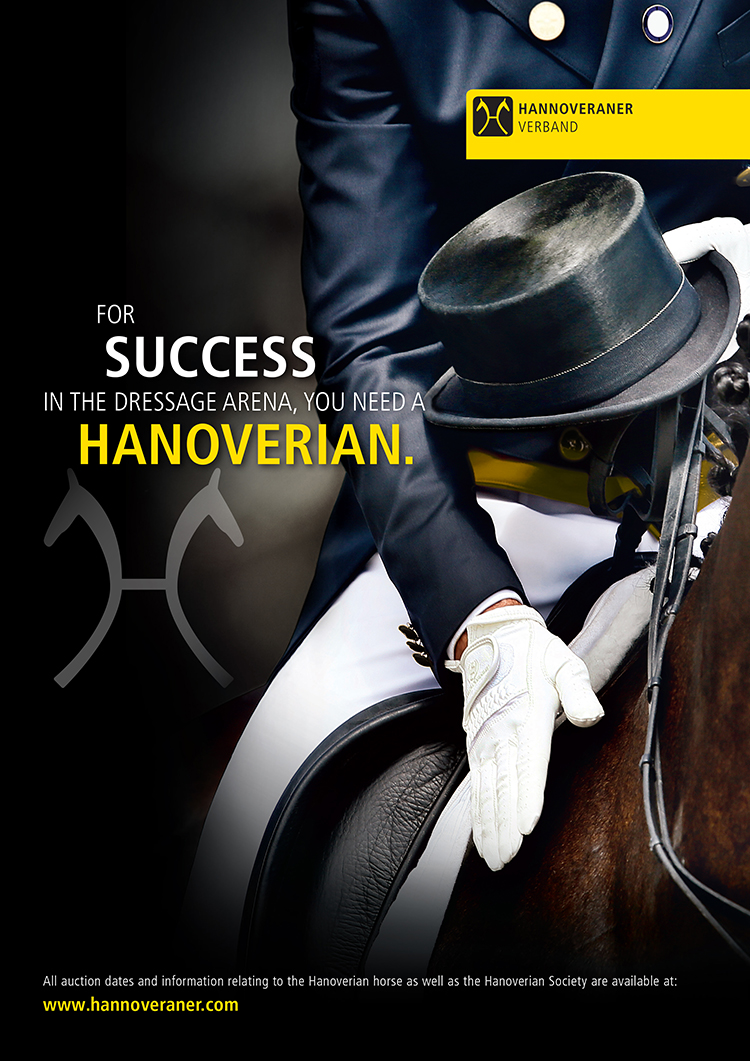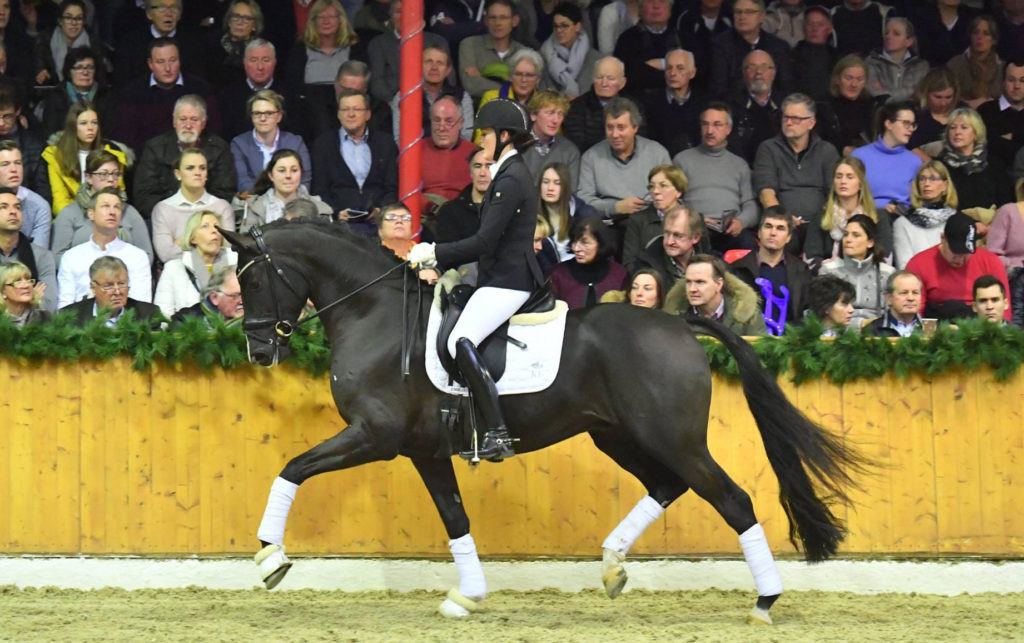The classical principles really do work – and the result is beautiful
Training with Johan Hamminga and Jennifer Sekreve
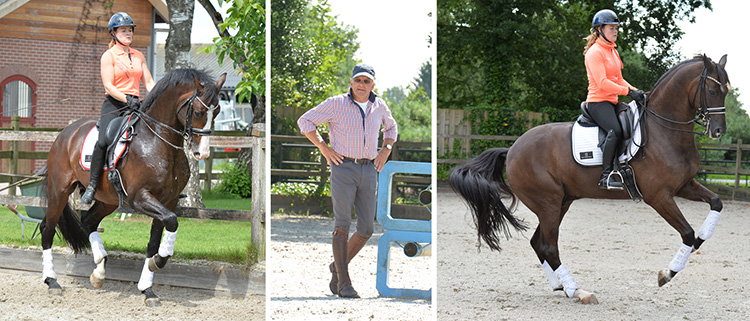
Story Christopher Hector, Photos – Roslyn Neave
It was five years ago when we first met Johan, everything about the Hamminga stables and training area rang true. Clean, neat, tidy, the tack in its place, heads with pricked ears looking over the stable doors, it had the air of a well oiled, sweetly running machine. In the arena was a guy I had only heard about – Johan Hamminga. I’d interviewed Adelinde Cornelissen at Aachen, when she made her stunning debut with Parzival on the international stage. Her third international show, her first out of Holland, and she beat all of the top of the top, with the exception of Isabell Werth and Satchmo. Who trains you? You won’t have heard of him, Johan Hamminga…
Johan has had a long and influential career on the Dutch equestrian scene. As test rider for the stallions at their performance tests, he rode some of the most important, from Contango to Jazz. As trainer of the Dutch Young Horse squad, he shaped the careers of many important horses and riders, but it all comes back to his little stable block and indoor school at Elspeet, one of the most beautiful places in the world, with its beech forest, and acres of purple heath – the Heide.
We were there the first time, as part of the KWPN’s Stallion Show study group, held for foreign visitors on the day after the Stallion Show in den Bosch. Johan immediately had the group enthralled as he talked about the relationship between conformation and dressage ability, then we were really blown away by the riding of his partner, Jennifer Sekreve. Jen has the most perfect seat, her hands and her body flow sweetly with the movement of the horse, she has absorbed Johan’s quiet classical approach and beautifully puts it into action.
We saw some wonderful horses on that first visit, but we were really taken by a handsome black three year old, San Siro a German-bred stallion – by San Amour out of a De Niro/Andiamo/Argentinus mare. Johan told us at the time:
“I bought him in a foal auction in Germany. I liked the bloodlines, but also the topline connection – the wither to the back to the loins to the croup. His negative point is his neck, it is long enough but it could be more up from the wither and cleaner on the bottom of the neck. The most important thing to look for is a body in good proportion, with an uphill tendency and connected from the front to the back. One of his problems is that he is so big. He is 173 cm and he grew three or four centimetres last month. That takes a lot out of them, he is really muscled more like a two-year-old than a three-year-old.”
Dressage makes the horse stronger, more athletic, more beautiful, San Siro
Since then we have been regular visitors to Elspeet, and watched the gawky colt mature and strengthen under Johan’s guidance. That’s the theory isn’t it? Dressage is supposed to make the horse stronger, more athletic, more beautiful… it’s great when that actually happens.
So there we are, a couple of days before the World Young Horse Championships are about to start just down the road in Ermelo, and Jen and San Siro will be competing there in the Prix St Georges.
The warm up is as always, a quiet progression as Jen canters around the outdoor arena – now that is a change, it’s summer for this visit, I’m wearing a polo instead of shivering in the indoor under a pile of horse rugs…
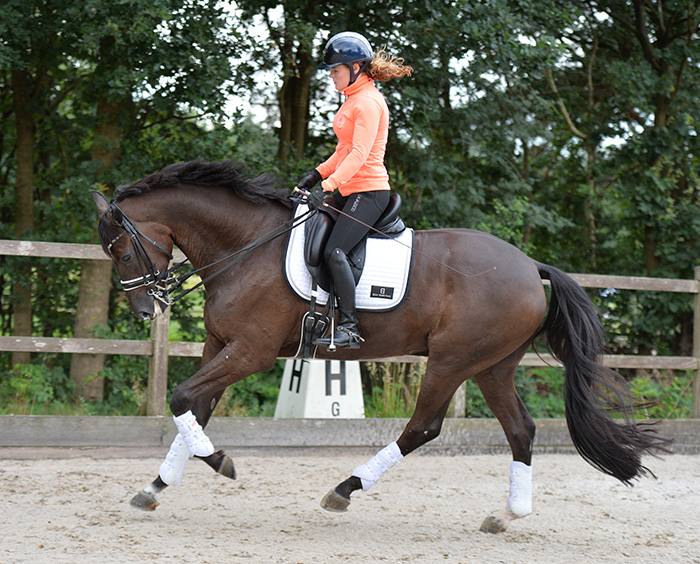
Johan comments on the photo:
There is a lot of bending through the whole body, there is a real contact and behind the saddle, there is an uphill tendency. He is stretching his left hind leg optimally. He should be a little bit more forward with his nose, but it is good on the reins, you can see the muscles in the topline of the neck, they are working, stretching.
“Change the tempo, but come out of it not so quick, it is important to keep the balance in the change of tempo. Give a little more the reins, then collect a little – but only collect when he is supple in the neck. Change the tempo, more balance, more impulsion…”
Jennifer has the gelding in a slow, slow canter, riding through a beautiful half pirouette…

Johan comments:
I like this very much, because in this picture he is carrying the weight on the right hind leg. The canter is three beat, he is landing on the outside hind leg, then outside diagonal and then inside front leg, the three beats. And in this picture you see that the inside hind leg is two or three centimetres first on the ground, before the outside front leg. That’s the reason that the diagonal is broken a little bit, two or three centimetres – that’s the reason that the horse is up in the wither. You see it also here, the horse is five to ten centimetres higher in the wither than in the croup. In this moment the horse is carrying much weight on his hind legs and then the diagonal is a little bit broken by placing his inside hind leg first by two or three centimetres. Often we see horses, even in the Grand Prix, they are landing first on their outside front leg of the diagonal pair and then on their inside hind leg of the diagonal pair, then we have a horse short in the neck, down in the wither, and that is why the horse is landing on the outside front leg first, and that is wrong! But this is a very nice picture, you can see it in his ears and his eyes and in the mouth. It could be a little bit more up in the neck, a little bit – but there is a real contact, smooth contact, and in the body, the wither is higher than the croup. You see it also in the legs.
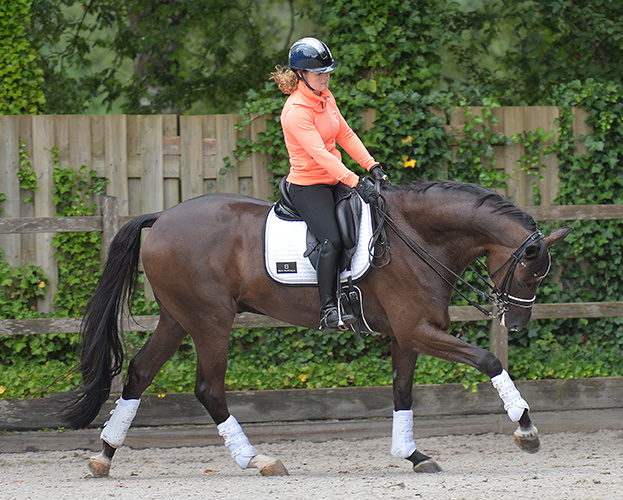
“Good, but between the collection, let the neck fall down – longer, deeper, longer your reins, let him stretch a little more.”
Johan comments:
That’s a good picture, that’s a picture where the whole neck falls down, he stretches and uses his back muscles. It’s logical, the hind legs are connected with the muscles from the hock to the loins, to the back, to the wither, to the neck, to the ears. There are groups of muscles, but the hind leg is indirectly connected behind the ears. When there is one muscle that doesn’t work, or works wrong, then the hind leg cannot do its work, it is so simple. Why is this a nice picture? Because you can see that his inside hind leg is carrying more weight because that pastern is horizontal and his left hind leg is 45 degrees. That’s the reason you bring the neck in this position because you give more freedom to the hind legs to carry more weight at different phases of the canter, and all the muscles of the top line are being used in the right way.
It’s an interesting way of putting it – ‘let the neck fall down, don’t pull it down, create a situation in which the horse wants to let go his body and relax his neck…’
“Take your time that your horse is more relaxed, then he can really collect.”
And as he collects, he comes up into a different outline: “Keep the poll the highest point, keep the poll in front of you, bend, then soft on the inside rein.”
Then it is back to the relaxing work…
“Let the neck down, work on making him more supple on the top line.”
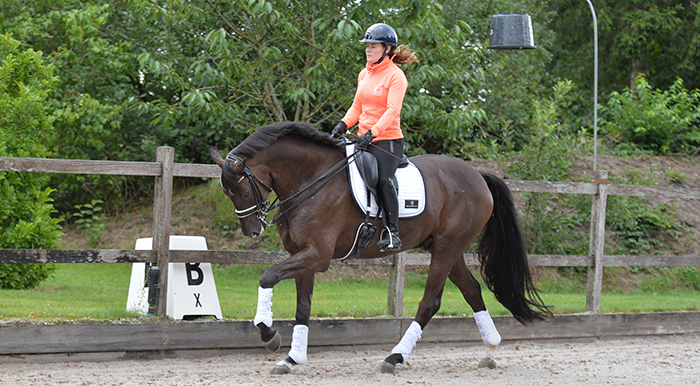
Johan comments:
It’s very important when you are cantering on the left, that your horse is bending a little to the left because his inside hind leg goes more forward than his outside hind leg, that is the reason the horse is bending a little to the inside. But if you are cantering left, and only bending left, then they lose a little impulsion on the outside shoulder – then you make your horse straight, or ask a little bit on your outside rein, then you bring more control of the shoulder, to bring the shoulder a little more to the inside and that’s what you need when you make flying changes.
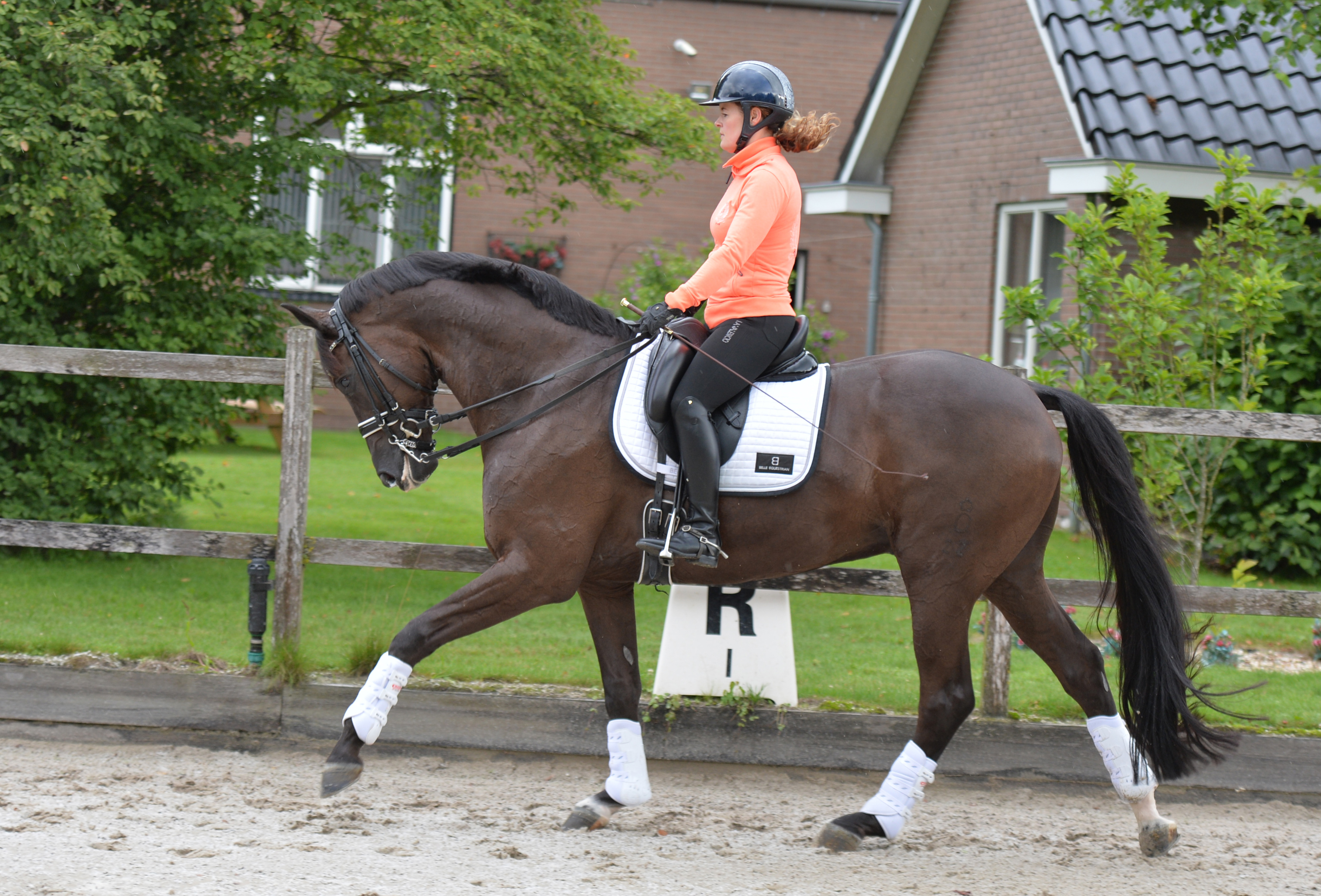
When you make a flying change, you have to bring the shoulder to the left for the flying change to the right, you have to bring the shoulder to the right, for the flying change to the left. That is why we make a little bit of an outside bend, only a little bit behind the jaw, the cheek, only that, and that is enough to give more control of the outside shoulder and that brings the horse more in a vertical balance – otherwise, when you are cantering, the horse is falling out through the shoulder. Here, you pick up the right shoulder and place it in line with the hips.
And back to some more collected work…
“On the outside rein, soft on the inside rein, small tempo changes, but keep the horse in front of you. We must keep the forward tendency even in the collection.”
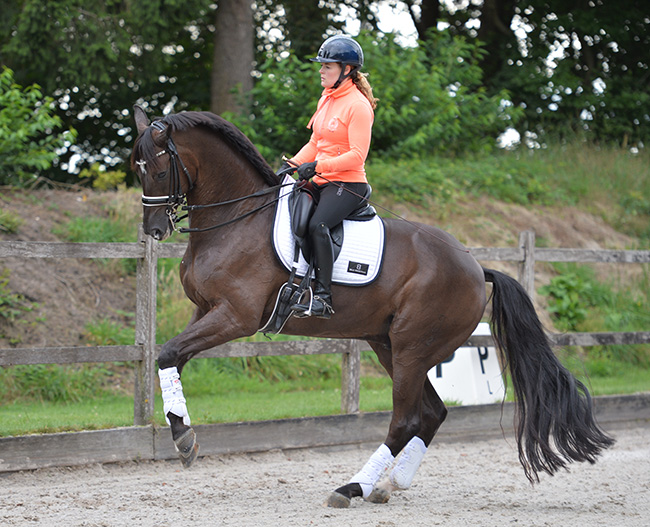
Jen rides another half pirouette:
“There, there, that is the balance. Let him wait…”
The pirouette is wonderful.
“Give the rein, ask for a more relaxed topline, let him use his legs under the body in a better, more forward, way.”
Time for a walk. Time for Johan to pick up the long whip. Not that he actually touches the horse with it as he walks behind, crooning, brave, brave… And the short steps come.
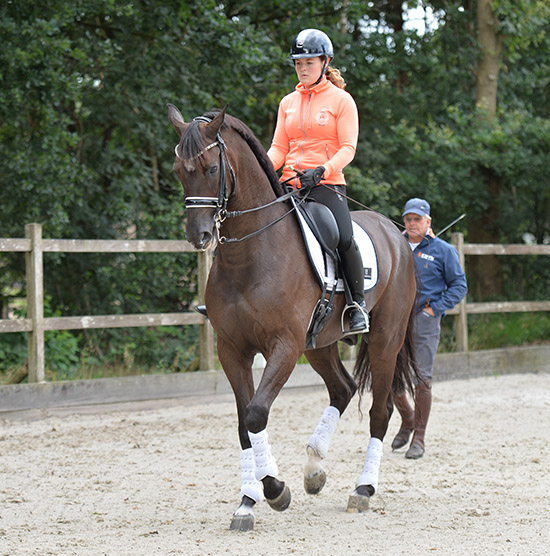
Into canter, it’s a super big canter, the frame is perfect now.
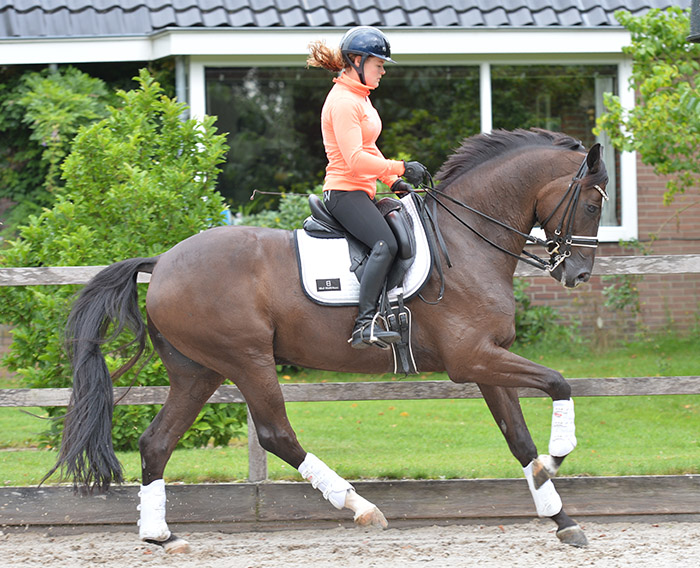
“Make the changes up and forward, in training take a little risk, up and forward, bigger. YAAA.”
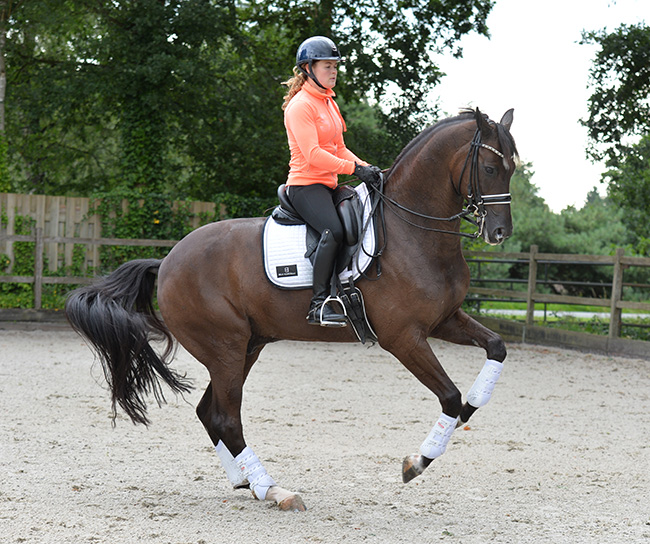
In the pirouette, Jen is asked to keep the horse more on the diagonal: “The first strides were too sideways, keep your diagonal..”
“That’s good, more fluent. In the first one, you wanted to collect too much and lost the rhythm. That is enough for today.”
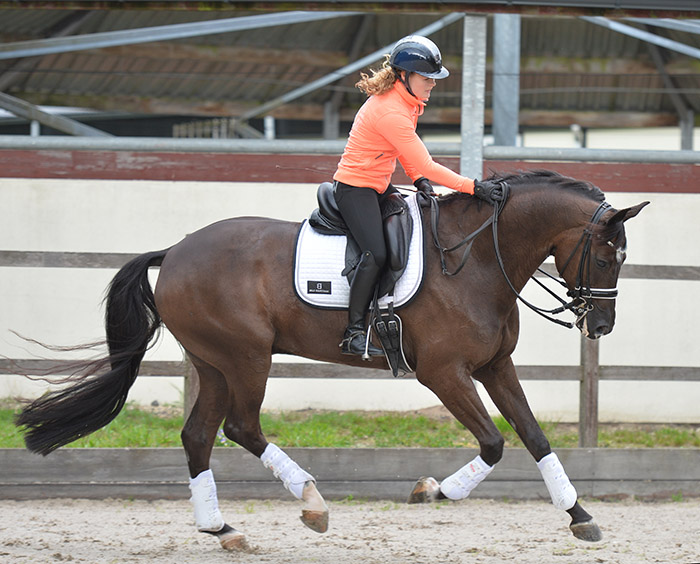
Johan comments:
Moments of relaxation are very important. This is a nice moment, Jen is a little in a forward seat, the Italian d’Inzeo light seat – the horse is in balance, it’s on the outside rein, giving with the inside rein. He is relaxed, he’s looking forward. When you give relaxation to a horse, some riders think that’s when we give the reins as long as possible, then there is relaxation and the horse is better in the back muscles, better through the whole body – that’s wrong! When you sit on the horse’s back there has to be always, a small contact. Even with long reins there has to be a small contact – you bring the head and neck position down, there has to be small contact and you have to take care of the rhythm, you have to take care of the tempo. You need the contact because when the rhythm becomes higher and higher and the tempo becomes higher and higher, then it is like a wheel barrow rushing down a hill. When you give relaxation the horse still has to be in balance, and develop a small impulsion so that the rhythm can be low, that the tempo can be low, and there is a real control of tempo and rhythm with your rein, that’s very important. But often you see riders just throw away the reins, and the horse is falling down on his front legs and going faster and faster. That’s not what you want.
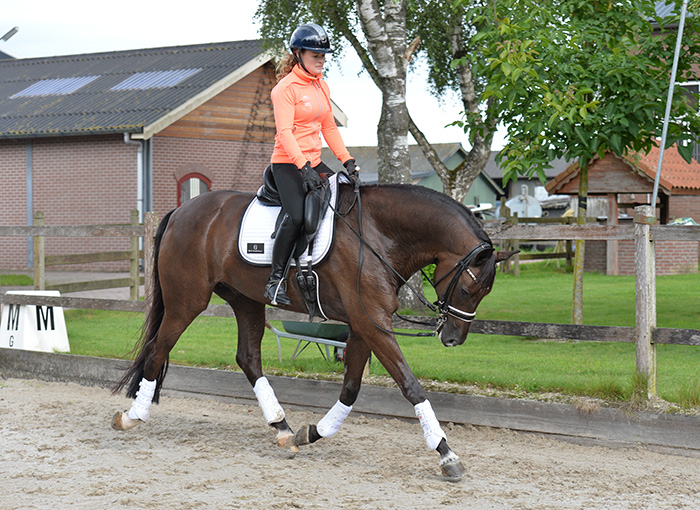
Jennifer rides another horse next
The next horse to be worked is a huge chestnut mare, Gamante. By Contango out of a Jazz / Amor / Pericles mare, as a three-year-old she was the Dutch champion Mare. Now six, she has been competing in the Parvo Cup competition.
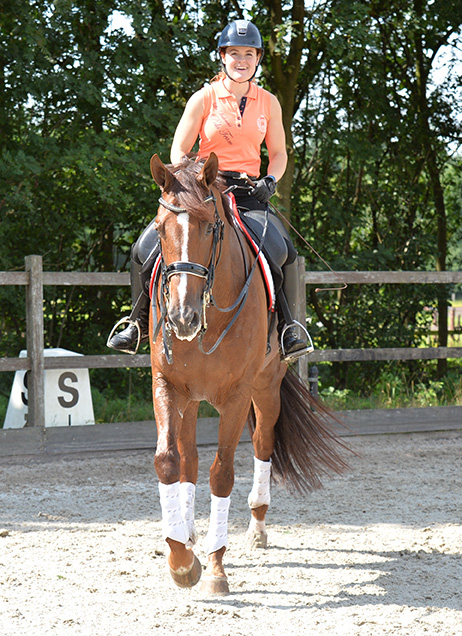
You’ve met Gamante before, she was Grace Kay’s ride when she visited Johan and Jennifer in 2015.
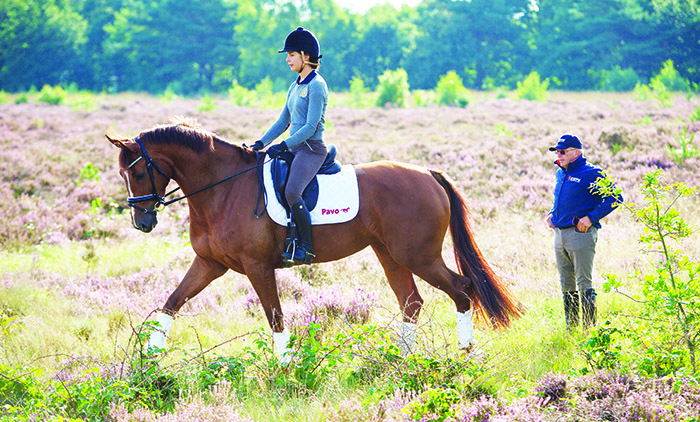
Here they are walking out on the beautiful ‘Heide’ where Jen frequently works all her horses, read Grace’s story of her time working with Johan and Jen: http://www.horsemagazine.com/thm/2015/12/grace-kay-looks-for-inspiration-in-europe-part-two/
Jennifer talks about the challenges she faces with the mare:
“As the exercises get more difficult, she gets better and better. She finds things like the flying changes easy. She hasn’t got the sort of walk that would score in the young horse classes, but I think next year, she will be competitive in the seven-year-old class. She needed some time, that’s why we didn’t do the young horse classes, her movement is correct, not spectacular, now she is six and her time is coming, she learns so quickly.”
“In the beginning she had a tight top line and I would take her out hacking, for one and a half hours, until at the end she dropped her neck and gave her body. She needed to do that, so I could start working with her body.”
And in line with that thinking, the warm up is a fine, forward, bold canter…
“It’s a nice gait for some horses to warm up,” Jen explains. “It gets them using their whole body, you don’t have to push them to get a more supple body.”
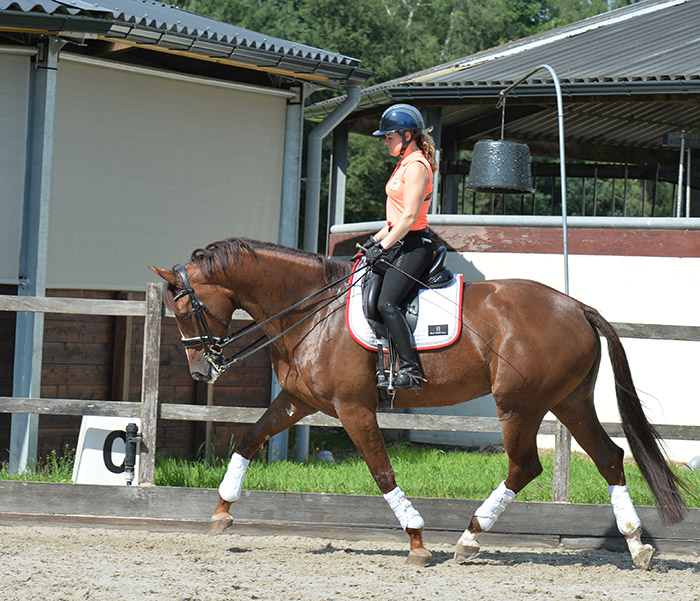
Johan comments:
That’s a nice moment, the horse is good in the tail, relaxed in the top line, soft on both reins, the neck falls down from the wither, the ears are pretty, eyes pretty, mouth is closed – smooth, a real contact on the bit, much foam, chewing… For me, in training, that’s a very good picture, but it’s a little bit too much behind the vertical. Here you see the inside hind leg is stretching very much, and there is an upward tendency in the whole topline, the mare is working in the right way, but the nose should be a little more forward, but she is not pulling, and the mouth is closed, there’s foam, eyes okay, ear is okay, the tail is okay – she comes up in the body. That’s why the Dutch people ride a bit more behind the vertical, that’s what Anky means, but not everyone has done it in the right way.
When the horse is forward, when the horse is using his hind leg more under the body and the neck falls down from out of the wither, then it doesn’t matter if the nose is a little behind the vertical if there is no pulling by the rider. Pulling is always a disaster.
Johan is back in his chair in the corner of the arena: “Tempo changes, let her drop down her neck, with her you have to feel a little more pressure in our hand, with her, she can be too light. When you get more contact, there is more connection behind. Now the neck is too short, too high, there is not enough relaxation in the top line, let the neck fall down and now with this softer top line, collect a little with this lower position.”
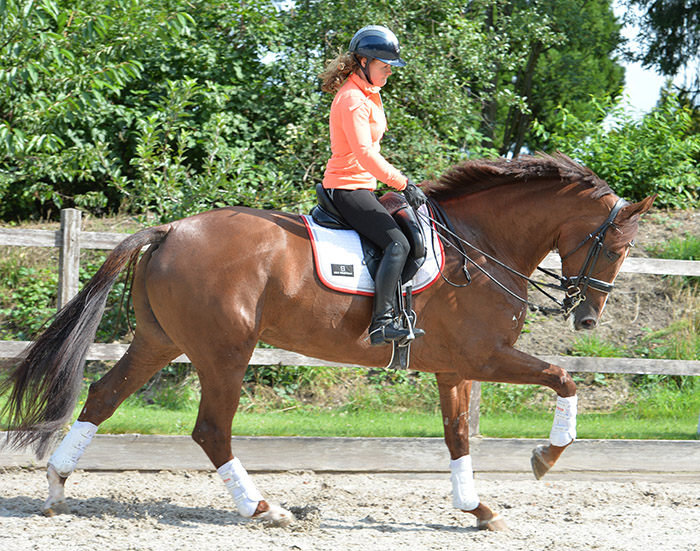
That’s a very nice picture. Okay the nose could be two or three centimetres more to the vertical but it’s soft in the reins. It’s good because the horse is in balance and she carries more weight on her inside hind leg because her inside hind leg is stretching under the body and she carries not so much weight on pair leg of the diagonal, her outside front leg. The horse is bending a little to the right, very soft on the inside rein, you train a horse so that she is stretching the outside muscles, and the inside muscles have to be a little shorter, this is the way you make your horse more supple, and it is how you prepare for the half pass and the pirouettes.
“Lift your inside rein to bring her nose a little to the vertical, now she has better balance, now she has better rhythm, now she carries more weight.”
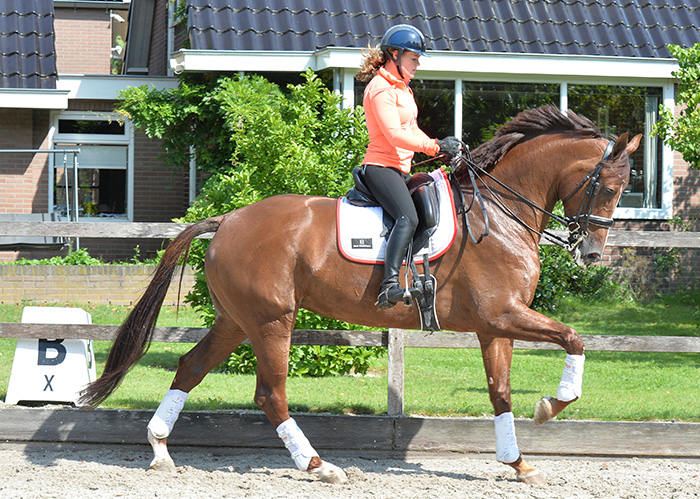
Johan comments:
Here the horse is more in the test position. What I like in this one is that the left front leg is placed in front of the body because the horse is in front of the rider and there is enough drive in the horse, and that is very important for dressage training, that the horse always has the idea – I can go forward. Nice in the top line, inside hind leg is carrying more weight than the pair diagonal front leg. Again the nose could be just a bit more on the vertical.
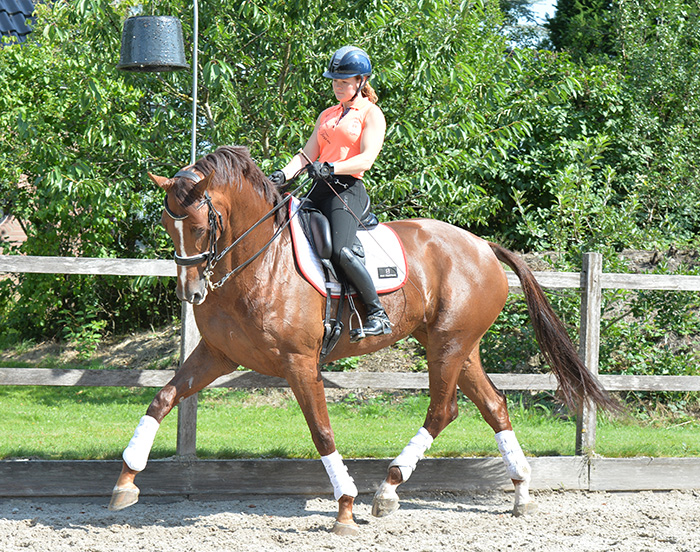
Johan comments:
That’s a nice shoulder in… you can see that the horse is bending in the body, and she makes bigger steps, especially with the inside hind leg – and she is placing that inside hind leg in the middle, under the body, and that develops more self carriage, and develops more freedom of the shoulders. Shoulder in is a preparation for the half pass, plus shoulder in gives more connection on the outside rein. Shoulder in makes more suppleness. Shoulder in is a most important exercise, but what is also important is how do you train it. There are a lot of people who are only looking to see the horse is on three tracks, but it would be better to ride on two tracks, than ride three tracks with the horse placing his inside hind leg to the outside, then it is wrong. The horse has to place the inside hind leg under the body. It’s the same with the transition – how do you make the transition? How do you make the shoulder in? How – that’s the most important thing. It’s good to do tempo changes in the shoulder in, that the horse accepts the bending, accepts the rhythm, and accepts the outside rein, and is 30 degrees in the shoulder in position, then you can make tempo changes, but when you start with tempo changes too early in the training of the shoulder in, then the horse cannot combine it all.
I trust by now that people who haunt the web with their absolutist view on frame – half a centimetre behind the vertical and the whole tradition of classical dressage crumbles – have left us, and gone to denounce Johan, Jen and yours truly for our heresy. The truth is, these people have never made a real flesh-and-blood horse, if they did, they would realise that on the vertical is a goal, not an absolute necessity, or even wise, position at certain points in the training of a horse, any horse. – CH
another horse follows
The last horse to be worked is the seven-year-old stallion, Ferrero.
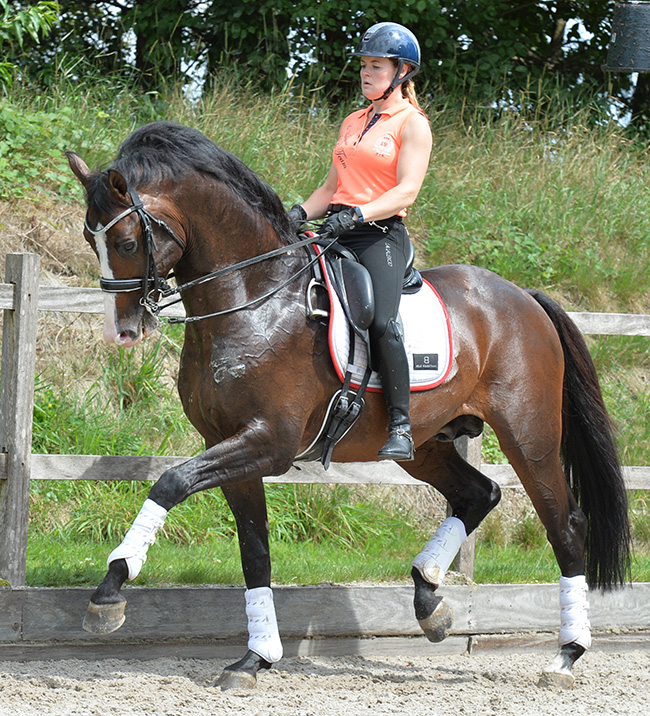
Ferrero is by Rhodium out of an Olivi / Frühling / Caritas mare, it’s a famous mare line that has produced stallions like Dutch Boy and Grand Prix competitors like Vivaldi and Cabochon. Last year he competed in the Seven-Year-old class at the World Young Dressage Horse championships, he is now competing in the class before the Prix St Georges, with a St Georges start later in the year planned.
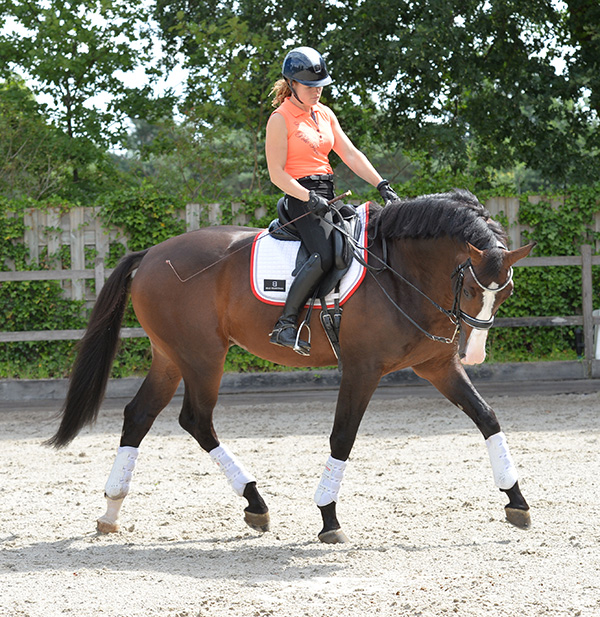
Johan comments:
Here you see that the neck is in a horizontal position, out of the wither. When you start the training session in walk and in trot, you have to prepare, so that your horse is forward and on your legs, he is listening to your leg aids, to your rein aids. You have to warm up because he is going to use his muscles in an intensive way and you need some bending to train the horse that all the muscles are available and prepared for the higher exercises.
Johan explains: “Today is Monday, he wasn’t worked yesterday, so he is a little stiff. We will give him more canter work, longer and deeper, until the feeling is okay in the seat and the contact.”
“Okay, now he is more supple and elastic, he can carry more weight and can collect a little. The horse has to learn to have more suspension, more bending in the hock and the knee. We use the transitions to make him more supple in the loins, in the croup, in the hindlegs. It is very important when the neck falls down that his nose is vertical so he can use his topline in a correct way. Now we see a more supple topline, and more fluency in the strides. This is so important, many trainers and riders say when the neck is down, the horse will be supple in the back – no, there are many lower positions where there is no contact, then the horse is not over the back, it is not working the loins and the hindlegs.”
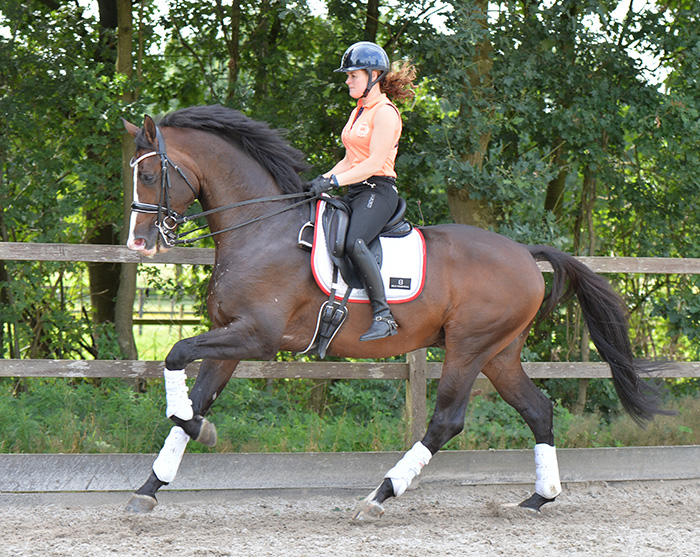
Johan comments:
That is a typical photograph showing the horse with a really good forward tendency, with an uphill tendency. That’s the neck in the right position, the poll the highest point, the nose a little bit in front of the vertical, open in the gullet. Looking to his legs, his left hind leg is first on the ground by a few centimetres in front of the right front leg. That is what we are training for, and Jen is riding without stirrups. Every day she rides one or two horses without stirrups – you try to find your balance better and better and better, so that you can sit very easily and independently.
“For a horse to be really good over the back, you need connection to both reins, and a forward tendency from behind. Two things test how the horse is over the back – enough bending behind, and smooth contact on both reins, then the back can stretch upwards. If you don’t do that, then you are on the wrong track.”
“The most important gait to show if the horse is supple in the top line is the walk. Looking at the walk, is it four beat, with overtrack, and regularity, the suppleness of the back, the neck out of the wither and horizontal, the whole body is marching. That is a sign of good riding.”
Johan comments:
This is in a real balance, nice and uphill in the neck, fine in the ear and the eye. The horse is in a horizontal balance. It’s good to see when a horse is in this balance, then you can build it up to a more collected balance. As a trainer you must always look to the ears and the eyes, when the horse looks very nice and the rider is happy, then there’s a good feeling, and there is also a better contact, and there is also better instruction. But when the rider is not in a good shape, then it doesn’t work, then you have to make the rider better in the head and more comfortable, and that is also better for the horse.
“Always ask a little more from behind, bend the horse so the inside hind leg is one hoof print to the inside and he is bending around your leg, then it is easier for him to bring his leg under his body. When you want to collect and make him more supple, have the inside hind leg one hoof print to the inside and make it easier for him to carry his body.”
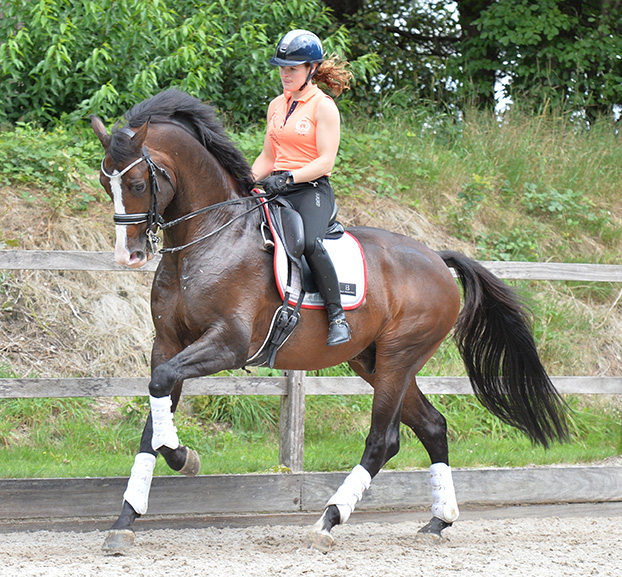
Johan tells us:
That’s a good photo, the horse is forward, it’s swinging and it’s good uphill. The neck is in the right position.
more follows
Jennifer is riding a big working pirouette…
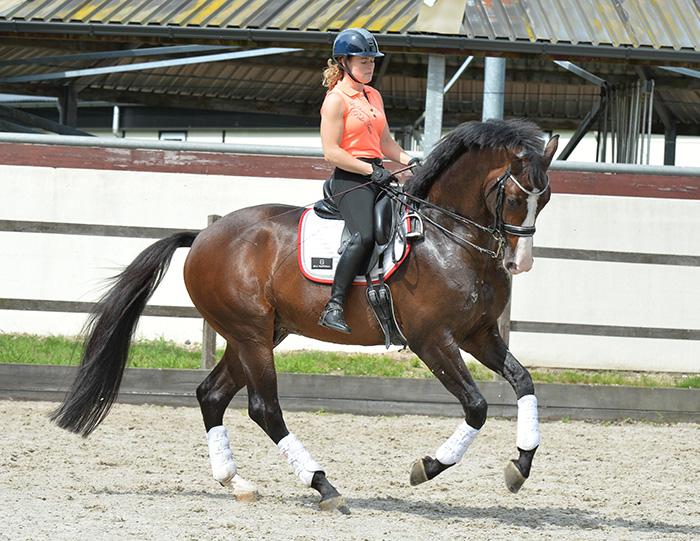
“Now you are training from behind, now you have the connection from the body to the bit. Now you have better rhythm, now he is down in the croup and carries more weight from behind. When you are working you have to always be looking, is it time we can collect a bit? Sometimes it is after fifteen minutes, sometimes thirty minutes. Now you have a better forward connection on both reins. As you collect more, there has to be a forward tendency in every second, every stride.”
“Now let him stretch a little bit more…”
Time to practice the changes and Johan is asking Jennifer to get the shoulders out of the way: “Move the shoulder right for left change, left rein soft, change. Move the shoulder left for the right change. Make more control of the shoulders.”
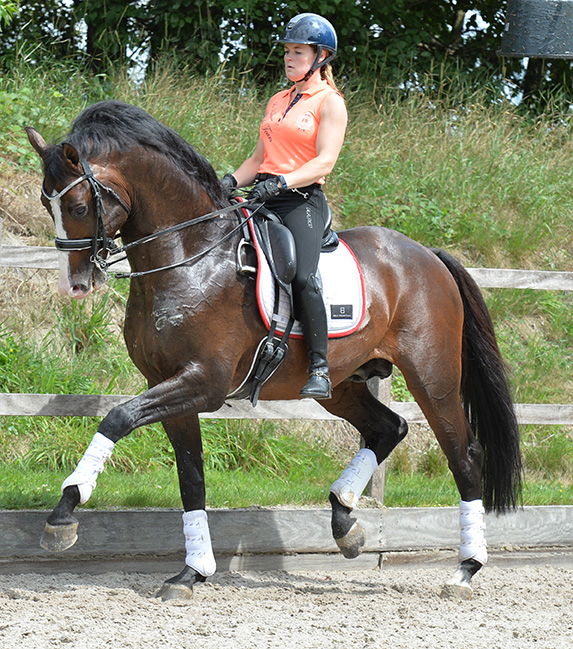
Johan tells us:
In this trot there is a lot of impulsion and the horse is good in the neck, longer in the neck, and he can use his hind legs in a better way, and that gives more impulsion and more uphill bending and tendency.
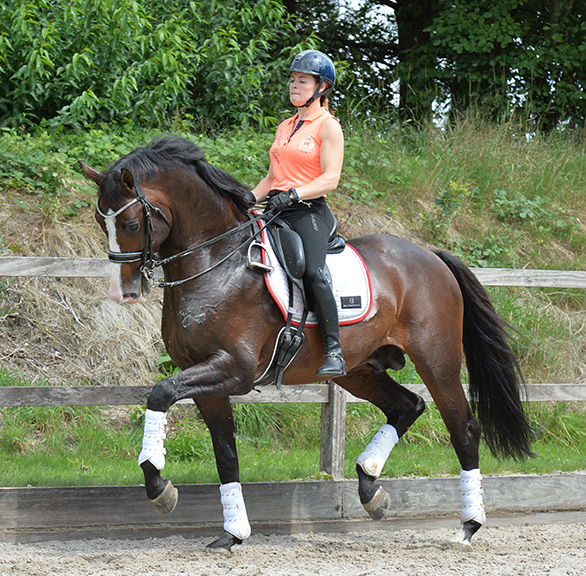
This is more collected trot. The horse is in a real balance because his right front leg is exactly in the vertical. He is good in the neck and the poll position. He can use his whole body, and there is a bending from behind so he can develop more self carriage.
It is passage time, and Johan is warning Jennifer not to ask too much:
“Look for short moments. The first five steps are the best, then stop, so he learns. Some months ago, he was too uneven, too tense in this work, so we ask more rhythm and balance before we ask for piaffe steps.”
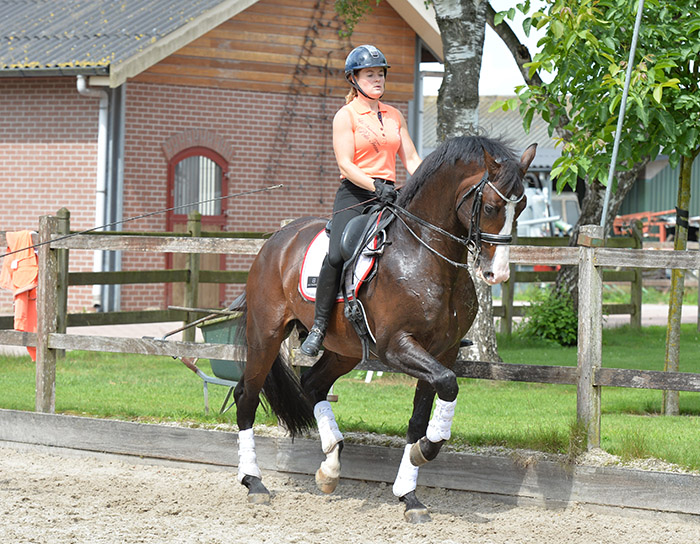
Johan tells us:
In this picture, we see a lot of strength and a good bending in the legs. The front leg is exactly lifted to level with the opposite half cannon bone, and the left hind leg is lifted ten centimetres. Good lift behind, and he is also in a good balance and the neck is uphill and good in contact. That’s a good first beginning of passage.
But Ferrero shows that he has learnt the lesson well:
“Jennifer says that the feeling this horse gives is so electric, so fine-tuned, that she says, this is my best one ever.”
Some people have the idea that it is never correct, never classical, for the horse’s nose to go behind the vertical – but you obviously don’t believe this…
“It is better to keep the nose more on the vertical then there is less chance that you make big mistakes. But if the nose comes five centimetres behind the vertical and there is a real contact and there is a real forward in the horse, and he is using his hindlegs and his body well – then there is no problem. But behind the vertical with too much pulling on the reins, then it is a big disaster.”
You always say to Jen, Let the neck fall down – fall down, not pulled down?
“When the horse is really forward, when the horse is really listening to your legs, when the horse accepts the bit and accepts the contact, then when you give a little bit more rein, the horse falls down with his neck, so much as your hands go forward. When the neck falls down from out of the wither, then you have more muscles at work in the back, and in the loins. But when the neck comes up from out of the wither and there is a bend in the 3rd, 4th, 5th vertebrae, then it is not good. We want the horse to fall down in the neck, completely, and out of the wither, and then you see a topline which is horizontal, and that’s what you want – so he uses his neck, out of the wither, in a forward direction, then he can swing / wave in his back muscles and the loins.”
It is a scene that is played out day after day in the school at Elspeet, a scene that could teach the dressage world so much about what the classical principles really look like – hopefully the series of articles we have made with Johan and Jen, give you the opportunity to share Johan’s wisdom, and enjoy Jen’s riding…
Looking for top European bloodlines in Australia? Go to www.ihb.com and choose from stallions like:
Danciero
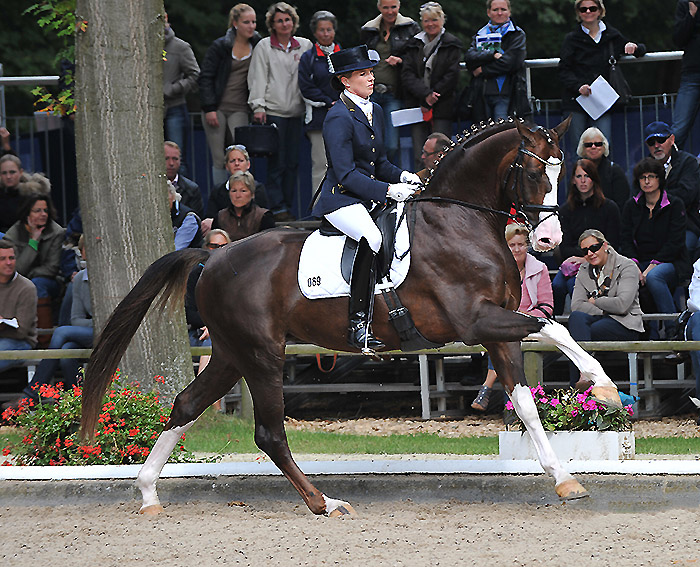
Benicio
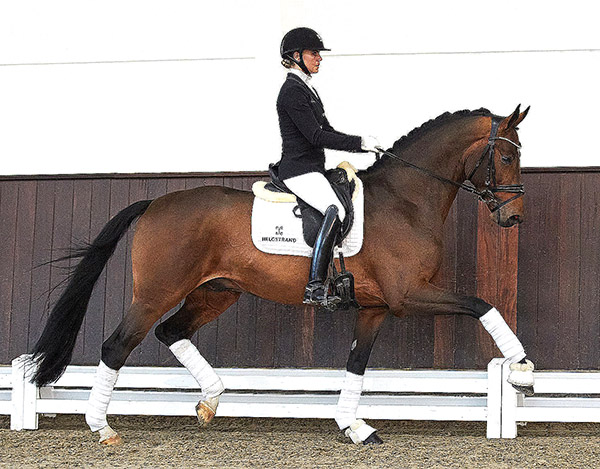
Or the exciting new young stallion, Be Sure




